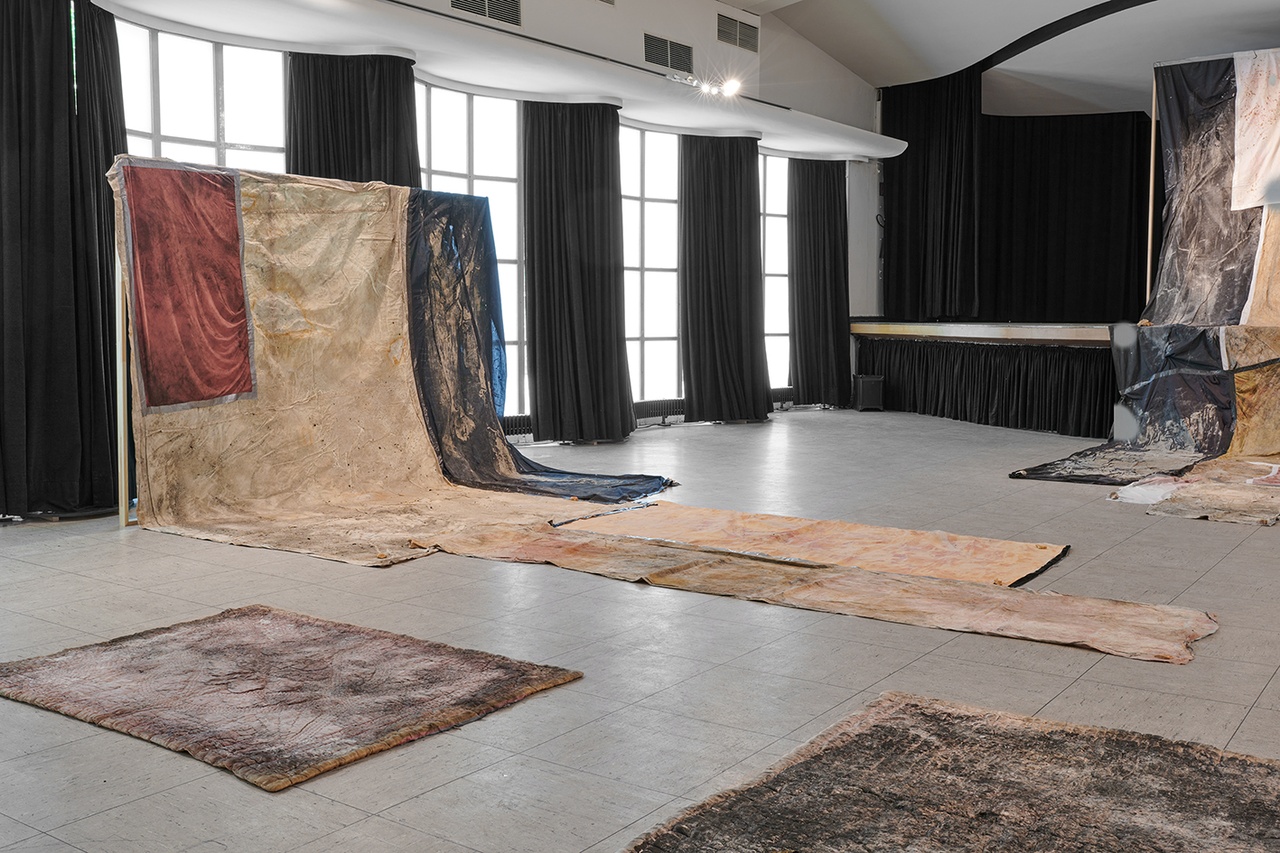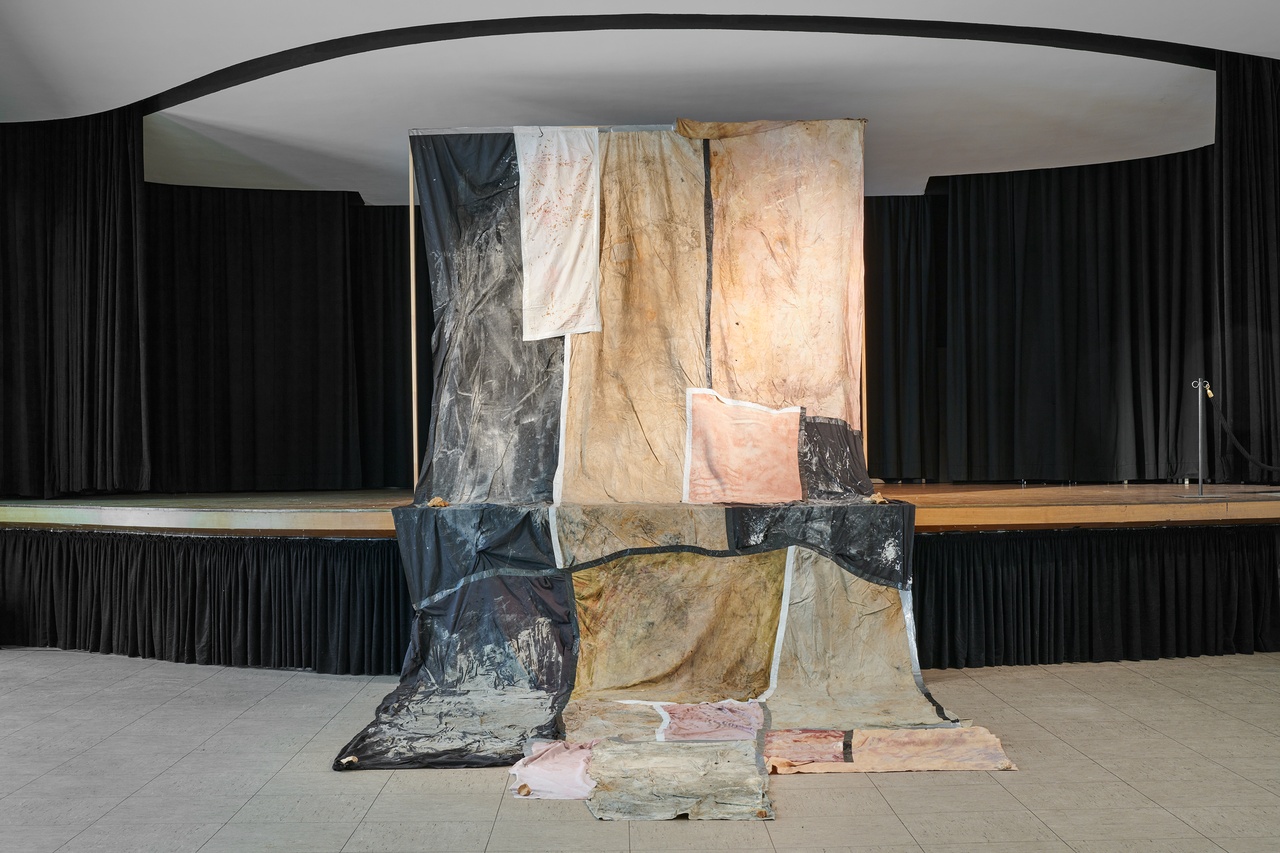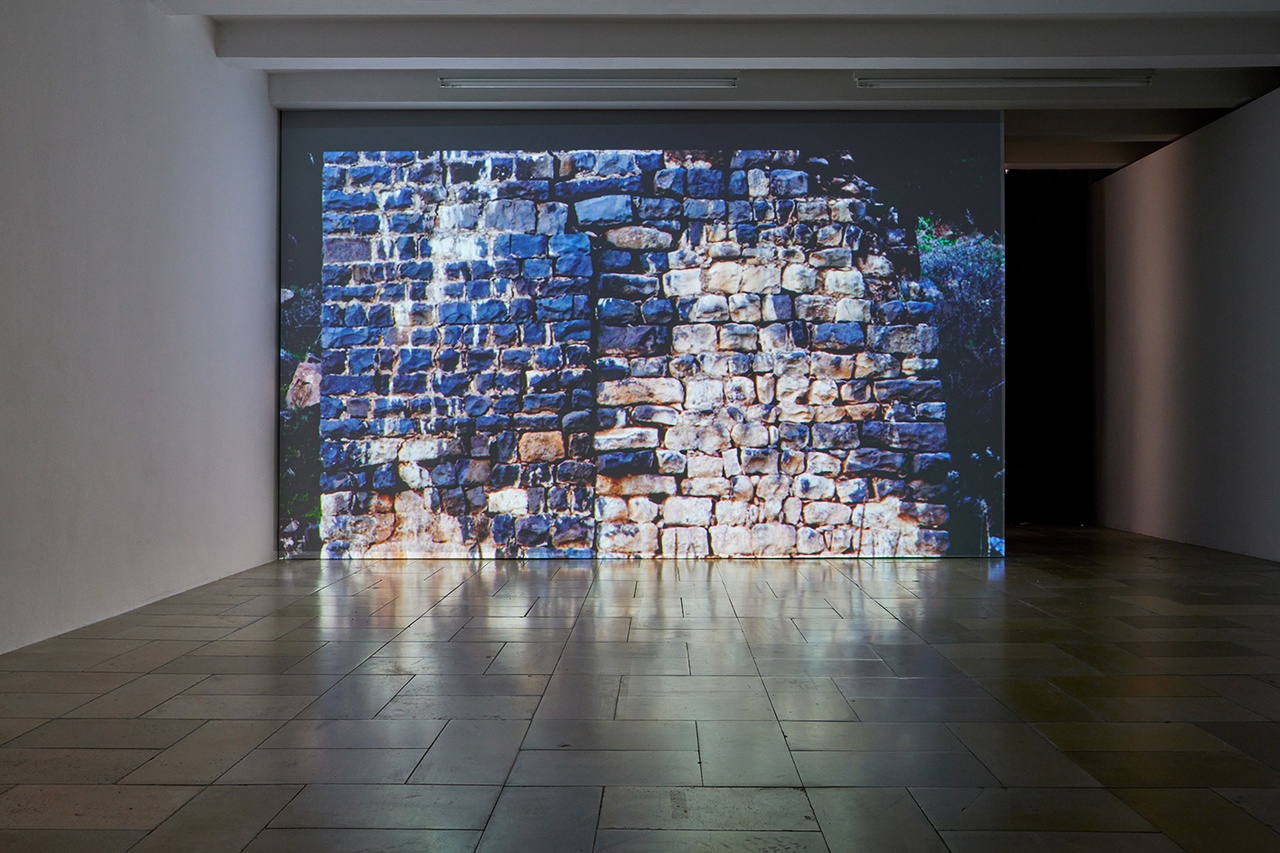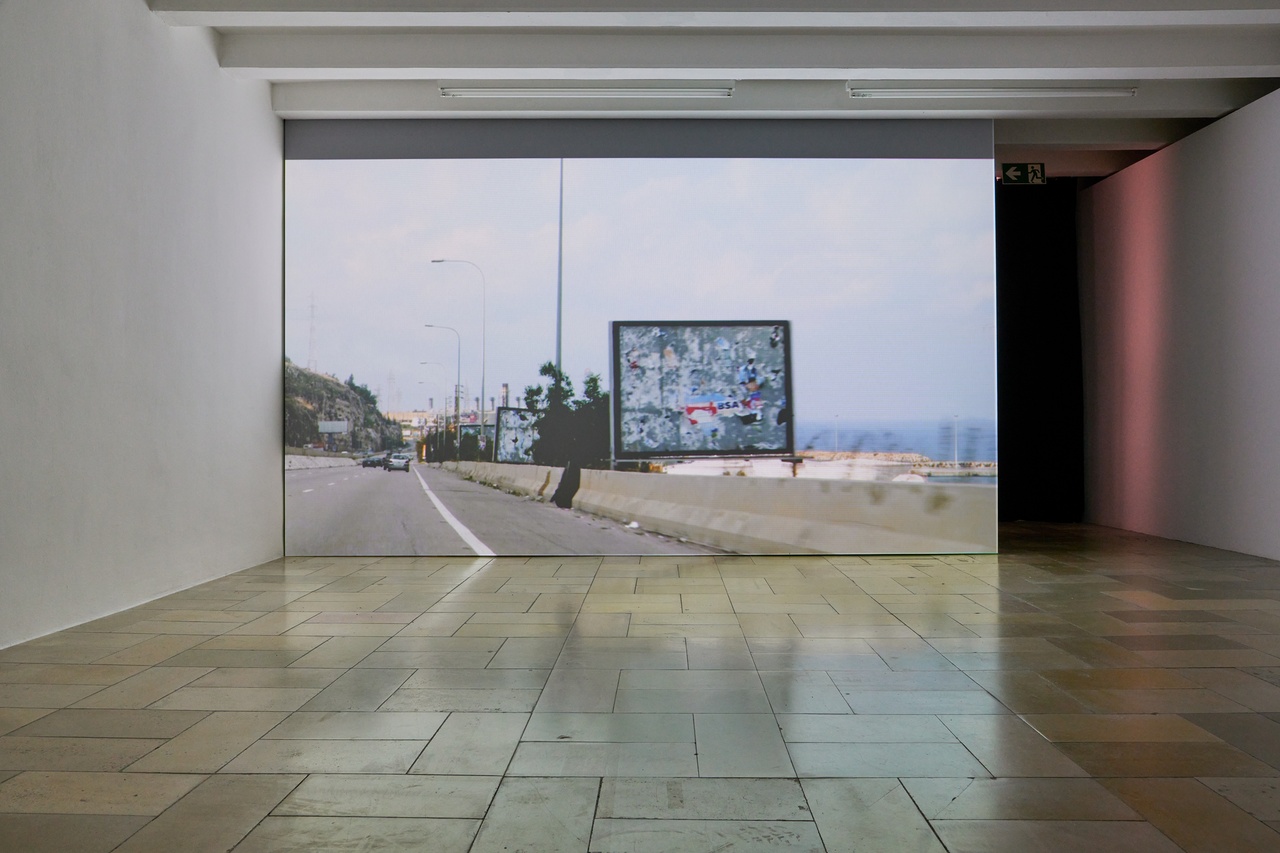STRATEGIC ABSTRACTION Stanton Taylor on Dala Nasser at Kölnischer Kunstverein, Cologne

“Dala Nasser: Red in Tooth,” Kölnischer Kunstverein, 2022, installation view
Looking at the world makes you sad; looking at pictures of the world, sadder. Not quite a call to action, images of atrocities more often than not confront us with our own complicity and indifference. They ask us to acknowledge our suppressed shame in the face of a more than barbarous world. When googling images of migrant ships stranded in the Mediterranean, the people always seem so small and distant – active though not necessarily alive. However heroic their individual journeys, the camera consistently renders them as helpless specks of matter caught in the crosswinds of vast socioeconomic forces seemingly beyond anyone’s control. As a rule, my algorithmic overlords inevitably decide that this is the right time to advertise tower defense games – on Instagram, Twitter, Facebook, wherever. In a feat of well-timed benevolence, they invite a lowly particle like me to share in the joy of defending those storied properties and values against the onset of the horde. And if I’m good enough, I can upgrade my catapults into laser beams. The overlords must know that my next visa appointment in Berlin is right around the corner. Then again, it always is. Of course, my papers aren’t in order and anxieties abound. In that moment, the singularity nudges sweetly: better toe the line if you wanna stay on the right side of history.

“Dala Nasser: Red in Tooth,” Kölnischer Kunstverein, 2022, installation view
Coming from the other half of the globe, much of what I’m about to say is probably just projection, but I can’t help but see something similar at work in Dala Nasser’s recent exhibition “Red in Tooth” at the Kölnischer Kunstverein: a sense of how to survive while playing an increasingly rigged game. Upon entering the Kunstverein’s Riphahn-Saal, I was greeted by two monumental textile works (Red in Tooth, 2020–2021–2022) draped on makeshift wooden frames. The smell of dry earth lingered in the air. Specks of dirt were scattered at my feet. Stapled and duct-taped together, the fragments of weathered fabric ranged from black to bloodied beige. Rich in wrinkle and blemish, their surfaces read like the testament of aging flesh. Meanwhile, Mhamad Safa’s soundscape of artificial clicks and rustles suffused the space at unpredictable intervals. For a moment, I imagined myself at a dig where alien archaeologists had just excavated the corpse of process-based abstraction from its all-too-belated grave.
Later on, I was glad to learn that the textiles were an ambivalent adaptation of the walls of mourning fabric commonly erected during Ashura – a holiday commemorating the death of Muhammad’s grandson Husayn ibn Ali, whose martyrdom is especially important to the political imaginary in the south of Nasser’s native Lebanon. Somewhat suitably, the characteristic surfaces of Nasser’s textiles were made by treating them with ash and charcoal, then leaving them out in the rain before burying them in the ground, where they stewed for months. But behind these formal allusions, there was also a more pragmatic economy of means at work. Nasser originally made the pieces for her MFA show, which took place last year in the United States, while she was waiting out the pandemic with her family back home in Beirut. Working with textile fragments was thus ideal since they could easily be folded up to fit in a suitcase and reassembled at an impressive scale once on-site. A simple-enough solution, but it also inscribes the challenge of circulating through Western “centers” while working in the “peripheries” on the level of matter and form.

Dala Nasser, “Red in Tooth,” 2021
Though rarely explicit, Lebanon’s tumultuous history looms large in Nasser’s practice. The accompanying film Red in Tooth (2021), for example, takes viewers through the Al Wazzani region of Lebanon, where Nasser’s grandparents are from and all the work in the show was made. Located within eyesight of what is now the border to Israel, the local landscape has been ravaged by decades of geopolitical conflicts: from petrochemical spills and human-induced droughts to ubiquitous landmines and blast craters. Shot from a speeding car, the film’s atmospheric images casually register the landscape in passing: mountains of trash, decaying infrastructure, desiccated trees, charred buildings, dead animals, and a water tower riddled with holes. Halfway through the film, an uncanny blue animation creeps across the screen, evoking waterways or maybe human veins. As the footage approaches the Al Wazzani river, the soundscape by Mhamad Safa escalates from ambient noise into an abstract electronic lamentation hovering somewhere between prayer and song. But before we can continue, some context.
Following Israel’s occupation of Southern Lebanon (1982–2000), which displaced roughly 75 percent of the region’s population, the Lebanese government launched a large-scale reconstruction program funded by allied Arab states. [1] Among other things, the plan included building a water pumping station at the Al Wazzani spring, whose waters feed the Hasbani River, a major tributary of the Jordan River. But when word of the project got out, Israel’s then prime minister, Ariel Sharon, promptly declared it a “casus belli.” [2] In the subsequent disputes, Lebanese officials argued that the majority of the water from the Hasbani was already being expropriated for Israeli use, while the relatively meager pumping station at the spring was only necessary to restore local water access and farming to pre-occupation levels in an otherwise devastated region. [3] On the other side, Israeli officials saw the pumping station as part of a larger plot to divert water from the Jordan River and thus endanger one of Israel’s major sources of fresh water during a time of drought. [4] Construction went ahead as planned, though the Israel Defense Forces would eventually end up shelling the station along with several other key water facilities in retaliation against Hezbollah during the Summer War of 2006. Supposedly, it was just collateral damage. [5]
How to bear witness to the interminable violence of resource extraction? Well, for one thing, the film isn’t the environmental horror show my description so far might suggest. Between the crumbling infrastructure and border walls, there are also moments of natural beauty: ghostly white trees in a reddened field; a chipper dog trotting along with its prey in its mouth. Moreover, the images are largely devoid of humans, and the only people we see are soldiers glimpsed from afar or local politicians’ images on posters, both indifferent to our passing. In the voiceover, some locals recount stories about wayward chickens and cows wandering across the border to be welcomed by the guards. The animals’ owners, however, were not. The focus here is on nature, and the film simultaneously seems to mourn the damage inflicted on the environment while testifying to its resilience in the face of human policies and borders. Elsewhere, Nasser has emphasized her strong feelings about “the way in which, for millennia, people moved freely through these landscapes from Beirut to Jerusalem to Baghdad, Alexandria and Istanbul and beyond, and yet for almost a century now this has been blocked by war and occupation.” [6] In this light, the appeal to nature also invokes an ecological timescale that renders human feuds fleeting by comparison. It may even hold out hope that the long view of natural history might one day serve as our guide.

Dala Nasser, “Red in Tooth,” 2021
With all the politics lurking in the background, it’s all the more striking that Nasser abstains from any clear position on the conflict, though in context it isn’t too hard to imagine why. While it might seem easy enough to wag a finger at the Israel Defense Forces’ disproportionate use of force, Hezbollah has since faced heavy criticism for recklessly escalating hostilities in the region at the cost of Lebanese lives. Meanwhile, accusations of corruption are regularly levied against local officials of all stripes for sabotaging the reconstruction efforts with ruthless profiteering. At the risk of courting censure at home and cancellation abroad, Nasser toes the line of what can be said or shown. The result is a delicate balance of measured silences, where the burden of witnessing the calamity of humanity falls squarely on natural processes bound to outlast us all. In that same shift, Nasser evokes the ironies of mobility in a supposedly globalized world – one where resources and commodities are made to flow freely across borders, while pesky people and their ideas may not. And for those of us lucky enough to circulate beyond the countries of our birth, continued mobility is always contingent on keeping our papers, and our content, in check.
In rarer moments of clarity, I like to think that the hollowing out of so-called Western values hasn’t been precipitated by postmodernism, identity politics, PC culture, or whichever paranoia is being peddled in a given week. Rather, it’s just a healthy adaptation to the pressures of intensified globalization. In other words, it’s the ever-increasing difficulty of believing what empire says it is, when faced with people who’ve seen what empire does. Though Lebanon’s recent history can hardly be reduced to the consequences of foreign meddling, there’s a palpable sense in which Nasser’s work has been streamlined to infiltrate the metropole from its former outposts. Honed at some of the most prestigious places on the planet, her approach has something of the good migrant’s grin: the disquieting deference of someone who’s mastered your language, knowing you might never have to understand theirs; a smirk to remind you that there’s a world of difference between hospitality and unequal exchange. For all its sensuous qualities, it’s that sense of restraint that makes Nasser’s strategic abstraction most haunting. She doesn’t so much try to tell us anything we don’t already know as point to the limits of what we’re able to hear.
“Dala Nasser: Red in Tooth,” Kölnischer Kunstverein, Cologne, May 14–June 26, 2022.
Stanton Taylor is a writer and artist working between the Rhineland and Berlin.
Image credit: Courtesy of the artist and Deborah Schamoni, photos Mareike Tocha
Notes
| [1] | Hussein A. Amery, “Water Wars in the Middle East: A Looming Threat,” Geographical Journal 168, no. 4 (December 2002): 313–23, here 314. |
| [2] | Quoted in “Israel Warns of War over Water,” BBC News, September 10, 2002. |
| [3] | Amery, “Water Wars in the Middle East,” 317–18. |
| [4] | Ibid., 319. |
| [5] | See Mark Zeitoun, Karim Eid-Sabbagh, and Jeremy Loveless, “The Analytical Framework of Water and Armed Conflict: A Focus on the 2006 Summer War between Israel and Lebanon,” Disasters 38, no.1 (January 2014): 22–44, here 27. |
| [6] | Quoted in Jo Lawson-Tancred, “Dala Nasser,” Canvas 103 (May–June 2022): 170–77, here 173. |
